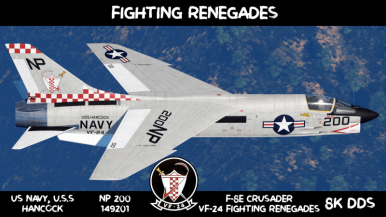
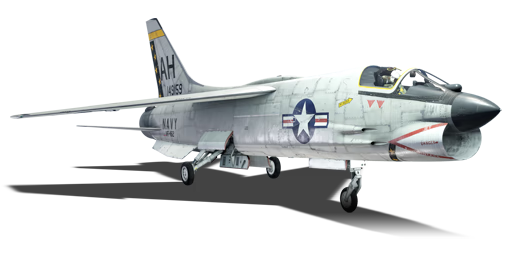


The United States Navy showed clear interest in expanding the capabilities of the Crusader series of aircraft as quickly as possible to expand its role in maritime operations and offer primitive close-air support capabilities. This led to the development of the F8U-2NE (later renamed the F-8E), which featured a larger nose cone, new AN/APQ-94 fire control radar, detachable pylons, a more reliable J57-P-20 engine, and guidance equipment for the AGM-12 Bullpup missiles. The first prototype, a modified F8U-1 (No. 143710), was flown on June 30, 1961, and the aircraft was quickly approved for use by the Navy. During the Vietnam War, the Marine Corps made extensive use of the F-8E, with squadrons like VMFA-235 considered to be among the best at using the aircraft in combat.
The F-8E Crusader was introduced in Update "Direct Hit" as the second Crusader variant in the American tech tree. Compared to the preceding F8U-2, it has largely the same flight performance but improved ordnance options. The infrared-guided AIM-9D Sidewinder returns as a good option for dogfights and sneak attacks, but it can now utilize the radar-guided AIM-9C, which may be useful during head-on engagements. The ground attack options are vastly superior because of the addition of wing pylons. While the F8U-2 was limited to cheek-mounted Zuni rockets and its internal FFAR rocket tray, the F-8E can carry a decent bombload and AGM-12 Bullpup air-to-ground missiles, making it more capable as a multirole fighter. The F-8E can really be considered "The Last Gunfighter" in War Thunder because the succeeding F-4J Phantom is a very different aircraft to cap off the US naval jet line: a heavy twin-engine fighter lacking an internal gun and relying on powerful long-range missiles.
flaps
flaps
flaps
brake
| Belt | Belt filling | Armor penetration (mm) at a distance: | |||||
|---|---|---|---|---|---|---|---|
| 10 m | 100 m | 500 m | 1000 m | 1500 m | 2000 m | ||
| AP-T/HEI/HEI | 42 | 39 | 27 | 18 | 11 | 7 | |
| AP-T/HEI | 42 | 39 | 27 | 18 | 11 | 7 | |
| AP-T/HEI/AP-I/HEI | 42 | 39 | 27 | 18 | 11 | 7 | |
| AP-T/AP-T/HEI/AP-I | 42 | 39 | 27 | 18 | 11 | 7 | |
| AP-I/HEI/HEI/HEI | 42 | 39 | 27 | 18 | 11 | 7 | |
| Belt | Belt filling | Armor penetration (mm) at a distance: | |||||
|---|---|---|---|---|---|---|---|
| 10 m | 100 m | 500 m | 1000 m | 1500 m | 2000 m | ||
| AP-T/HEI/HEI | 42 | 39 | 27 | 18 | 11 | 7 | |
| AP-T/HEI | 42 | 39 | 27 | 18 | 11 | 7 | |
| AP-T/HEI/AP-I/HEI | 42 | 39 | 27 | 18 | 11 | 7 | |
| AP-T/AP-T/HEI/AP-I | 42 | 39 | 27 | 18 | 11 | 7 | |
| AP-I/HEI/HEI/HEI | 42 | 39 | 27 | 18 | 11 | 7 | |
| Name | Weight | Slot | ||||
|---|---|---|---|---|---|---|
| 3 × | 353.7 kg |  |  | |||
| 6 × | 707.4 kg | 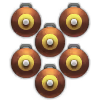 |  | |||
| 3 × | 722.7 kg |  |  | |||
| 4 × | 963.6 kg | 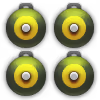 |  | |||
| 3 × | 414.9 kg |  |  | |||
| 6 × | 829.8 kg |  |  | |||
| 3 × | 762 kg |  |  | |||
| 4 × | 1,016 kg |  |  | |||
| 446.8 kg |  |  | ||||
| 2 × | 893.6 kg | 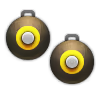 |  | |||
| 893.6 kg | 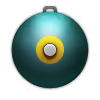 |  | ||||
| 893.6 kg |  |  | ||||
| 235.9 kg |  |  | ||||
| 7 × | 93.3 kg |  |  | |||
| 19 × | 229.7 kg |  |  | |||
| 38 × | 459.3 kg |  |  | |||
| 4 × | 280.3 kg |  |  | |||
| 8 × | 560.6 kg |  |  | |||
| 259 kg |  |  | ||||
| 72.6 kg |  |  | ||||
| 95.3 kg |  |  | ||||
| 88.4 kg |  |  | ||||
| 2 × | 145.1 kg |  |  | |||
| 2 × | 190.5 kg | 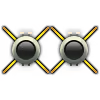 |  | |||
| 2 × | 176.9 kg |  |  | |||
| 2 × | 114.5 kg |  |  | |||
| 8 × | 458.1 kg | 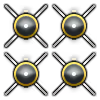 |  | |||
2 × | 187.1 kg |  |  | |||
2 × | 209.8 kg | 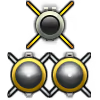 |  | |||
2 × | 203 kg | 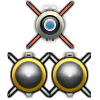 |  | |||












Flight performance |
|---|
Survivability |
|---|
Weaponry | |||
|---|---|---|---|
